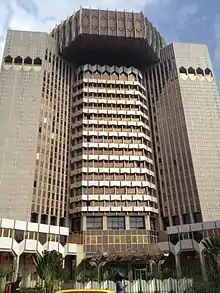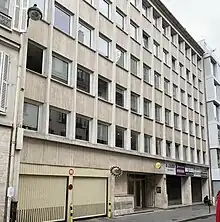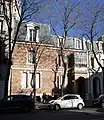Bank of Central African States
The Bank of Central African States (French: Banque des États de l'Afrique Centrale, BEAC) is a central bank that serves six central African countries which form the Economic and Monetary Community of Central Africa: Cameroon, Central African Republic, Chad, Equatorial Guinea, Gabon, and the Republic of the Congo.
 Logo of the BEAC  Headquarters of the BEAC | |
| Headquarters | Yaoundé, Cameroon |
|---|---|
| Established | 1972 |
| Governor | Abbas Mahamat Tolli[1] |
| Central bank of | Economic and Monetary Community of Central Africa |
| Currency | Central African CFA franc XAF (ISO 4217) |
| Reserves | 9 790 million USD[2] |
| Preceded by | Banque Centrale des Etats de l'Afrique Equatoriale et du Cameroun |
| Website | www.beac.int |

History
Background
In 1920, the French government expanded the note-issuance privilege of the Banque de l'Afrique Occidentale to its central African colonies of Congo, Ubangi-Shari, Gabon, Chad, and later Cameroon. This arrangement was disrupted during World War II, as the colonies controlled by Free France became Free French Africa.[3] The Caisse Centrale de la France Libre was established in London in December 1941 to manage the regional currency, and was renamed Caisse centrale de la France d'outre-mer (CCFOM) in 1944.[4] The region's currency was standardized in late 1945 as the CFA Franc.[3]
In 1955, the French government transferred the CCFOM's monetary role in the colonies of French Equatorial Africa to a new entity, the Institut d'Émission de l'Afrique Équatoriale Française et du Cameroun, which in 1959 was renamed the Banque Centrale des États de l'Afrique Équatoriale et du Cameroun (BCEAEC) after it became clear that the colonies would soon become independent nations.[3] The BCEAEC, headquartered in Paris,[5] acted as the new countries' joint central bank throughout the 1960s and early 1970s, similarly as its sister entity the BCEAO for the former colonies of French West Africa.
Establishment and development
On 22 November 1972, the five countries gathered in Brazzaville signed Financial Cooperation Conventions between themselves and with France that formed the basis for their continued use of the CFA Franc, rebranded as standing for "Coopération Financière en Afrique" instead of "Communauté française d'Afrique". Under these agreements, the BEAC was established to succeed the BCEAEC and manage the joint currency, with a convertibility guarantee provided by the French Treasury.[3] On 1 February 1973, the member states met in Fort-Lamy and decided to locate the new institution in Cameroon. The BEAC held its first board meeting on 13 March 1973 and started operations on 2 April 1973. The full transfer of head office activity from Paris to Yaoundé was completed in early 1977.[6]
Equatorial Guinea joined the currency arrangement and BEAC on 1 January 1985.[6]
On 16 October 1990, following similar reform pioneered by the BCEAO earlier the same year, the member states granted the BEAC a role of supranational banking supervision entrusted to the Commission bancaire de l'Afrique centrale (COBAC) within the bank. On 17 January 1992, a follow-up agreement harmonized banking regulation in the region, paving the way for the effective establishment of the COBAC in January 1993.[7] The COBAC is chaired by the Governor of the BEAC and managed by a permanent secretary-general.
In late 1999, a new statute reformed the BEAC's governance to ensure greater independence.[6]
In late 2011, the COBAC moved from its temporary location in Yaoundé to Libreville.[8]
Organization and governance
The BEAC has main branches known as National Directorates (French: direction nationale) in the capital or largest city of each of the member states. The BEAC also has branches in Bafoussam and Garoua (Cameroon), Berberati (CAR), Abéché and Moundou (Chad), Ouesso and Pointe-Noire (Congo), Bata (Equatorial Guinea), Franceville, Oyem, and Port-Gentil (Gabon).[6]
As of 2019, the BEAC is governed by a Board of Directors (French: Conseil d'administration). Its highest monetary policy making body is the Monetary Policy Committee (MPC, French: Comité de politique monétaire). The MPC consists of the Governor, two representatives of the French Government, and two representatives from each of the six CEMAC member states, one of which is the BEAC National Director for the country.[9]
Buildings
The buildings of the National Directorates typically dominate the local skyline,[10] respectively inaugurated in Bangui (1979), Libreville (1981), Yaoundé (1982), and N'Djamena (1994). In Malabo, the BEAC took over the former building of the Bank of Equatorial Guinea in July 1985. The BEAC's current head office tower in Yaoundé was inaugurated in 1988.[6] In Paris, the BEAC was located on 29, rue du Colisée, together with the BCEAO,[11] until it moved its representative office to another location in 2007.[6]
 Building at 29, rue du Colisée in Paris, seat of the BCEAEC then BEAC in the 1960s and 1970s
Building at 29, rue du Colisée in Paris, seat of the BCEAEC then BEAC in the 1960s and 1970s BEAC Tower in Yaounde
BEAC Tower in Yaounde BEAC tower in Brazzaville
BEAC tower in Brazzaville 48, avenue Raymond-Poincaré, the Paris office of BEAC
48, avenue Raymond-Poincaré, the Paris office of BEAC
Governors
- Casimir Oyé-Mba (1978 - 1990) [12]
- Jean-Félix Mamalepot (1990 - April 2007) [12]
- Philibert Andzembe (July 2007 - June 2008) [12]
- Lucas Abaga Nchama (2008 - 2017)
- Abbas Mahamat Tolli (2017 - to date)
Christian Joudiou, a French national, was the General Manager (French: directeur général) of the BEAC from 1973 to 1978.[12]
Controversy
Philibert Andzembe of Gabon was Governor of the BEAC from July 2007 until October 2009, when he was fired by the new president of Gabon, Ali Bongo, in response to a bank scandal in which $28.3 million went missing from the bank's Paris branch. In December 2010, a WikiLeaks memo dated June 3, 2005, said that Gabonese officials working for the Bank of Central African States stole US$36 million over a period of five years from the pooled reserves, giving much of the money to members of France's two main political parties.[13]
See also
- Banque Centrale des États de l'Afrique de l'Ouest (BCEAO)
- CFA Franc
- Central African CFA franc
- Economy of the Central African Republic
- Economy of Cameroon
- Economy of Chad
- Economy of the Republic of the Congo
- Economy of Equatorial Guinea
- Economy of Gabon
- Central banks and currencies of Africa
- List of central banks
References
- "Bloomberg Politics - Bloomberg". Bloomberg News.
- Weidner, Jan (2017). "The Organisation and Structure of Central Banks" (PDF). Katalog der Deutschen Nationalbibliothek.
- "Histoire de l'Emission Monétaire en Afrique Centrale". beac.int.
- "Caisse centrale de la France libre". Bibliothèque nationale de France.
- "Banque centrale des états de l'Afrique équatoriale et du Cameroun". Bibliothèque nationale de France.
- "1972-2012 : 40 ans d'histoire de la BEAC". beac.int.
- "La Commission Bancaire de l'Afrique Centrale". beac.int.
- "Regional banking regulator relocates to Gabon". Economist Intelligence Unit. 3 September 2011.
- "La BEAC : Un organisme de conception et de gestion de la politique monétaire dans la CEMAC". christattouh blog. 22 March 2019.
- René Boer (10 January 2014). "Two Banks Shaping the African Skyline". FA Failed Architecture.
- "Records of the Office of the Chief Economist". World Bank.
- "L'INSTITUT D'ÉMISSION DE L'AFRIQUE CENTRALE À TRAVERS LE XXE SIECLE". Banque des États de l'Afrique Centrale. June 25, 2008. Archived from the original on February 16, 2010.
- Gabon 'siphoned funds' to France Al Jazeera